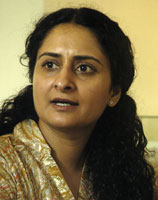Colombo’s Barefoot Gallery is hosting an exhibition and has launched two new book projects by three innovative artists now practising in South Asia. Sri Lankan artist Arjuna Gunarathne’s exhibition ‘Me, Myself and I’ was opened alongside the promotion of Pakistani artists Imran Qureshi’s and Aisha Khalid’s ‘Side by Side’ and ‘Name Class Subject’.
 |
 |
| Aisha Khalid |
Through their books, Qureshi and Khalid renegotiate the status of artwork as a pristine object aloof from the interactions of everyday life. Not to make their artwork out as arch and stuffy, far from it. Both are carried out with wit and irreverence. They do not wish for their viewers/readers to treat their works piously, as near-sacred objects they dare not touch. On the contrary, they want the owners of their books to draw on them, write on them, deface them, do whatever they like with them; it’s theirs after all. As the text buried within the pages of ‘Name Class Subject’ makes clear, “this book is intended to be written in.”
With ‘Side by Side’ Imran Qureshi offers up two individual books, which the title invites us to consider as companion pieces. Yet the difference is stark. One is a far larger production (209 x 275mm) called ‘The True Path’. It is an imaginative take on the children’s ‘join-the-dots’ playbook, where a line of numbered dots traverses from page to page across an abstract thread of natural forms, a landscape that turns from benign to sinister. Very much a narrative work, the line to be filled in by the ‘reader’, who, in an inversion of the traditional hierarchy becomes the final author of the work, becomes a heroic character in its own right and sets off on a picaresque adventure, leaping and falling, dodging missiles, scaling boulders, and transforming into umbrellas and trees.
Qureshi’s accompanying book ‘Moderate Enlightenment’ is by contrast a small hardback booklet (120 x 180) containing what at first appears to be a collection of Mughal-esque miniature portraits, beautifully rendered in the traditional style with bright slabs of colour and intricate brushwork. On closer inspection however, what at first glance seemed to be a Mughal courtier becomes a bearded man with a Nike satchel, while a hijab-clad woman is found to be wearing blue jeans.
These exquisite paintings aim for a more rounded human portrait of the pious Pakistani, who, despite the crude generalisations about Muslims that have proliferated during the American-led War on Terror, is fully capable of combining sincere religious faith with secular pursuits and concerns, and cannot be reduced to a person solely of his or her religion.
‘Name Class Subject’ is itself something of a double book project, although bound within one frame. It is drawn from Aisha Khalid’s schooldays in Pakistan, and captures the period of confusion and disquiet when English text books were introduced into her formerly Urdu-dominated curriculum. It is a juncture in her life in which her cultural certainties and very identity began to fracture.
From a state of innocence she was initiated into the complexities of a bilingual, post-colonial society in which proficiency in English is a fast-track to success and a badge of prestige. The book takes the form of a plain hard-back exercise book, with two front-covers on either side – with ‘Name Class Subject’ and the accompanying dotted spaces inscribed in English on one side, and in Urdu on the other; the former inviting the ‘student’ to work from left to right, and vice-versa with the latter.
The simple hierarchy of the two-tier language system is illustrated by the varying quality of the different sides, the English half features a more elaborate four-line layout on each page, while the ‘inferior’ Urdu half uses a plainer single-line format and is stuffed full of mocked-up printing errors, with pages unaligned or stuck in upside down with their corners dog-eared.
Despite its authentic appearance, the book is in fact a collection of over 300 original paintings of ruled pages, in the manner of traditional Mughal miniature painting. Furthermore, as above, the artwork is surrendered to the owner to be finished, he or she must write between the lines.
Arjuna Gunarathne’s exhibition ‘Me, Myself and I’ is, in a similar spirit, a profoundly autobiographical collection of miniature pen-on-paper line drawings that chart the Sri Lankan artist’s experience of alienation and cultural displacement while living in London with his wife and first child and working in a supermarket. Each one is a black ink self-portrait, cartoonish and often highly abstract.
Every full-length figure is deprived of a head, which is replaced by houses, mountain ranges, smoke trails and indiscernible, ominous shapes. Denying the subject of a face, the body-part through which communication is mediated, leaves him vulnerable and isolated on the page, and reflects the artist’s estrangement from those that surrounded him in London.
It furthermore robs the figure of a distinct identity, allowing it to extend beyond the self-portrait and embody the common immigrant experience. At times almost the entire body is obliterated by a storm cloud or black smudge marks, suggesting Gunarathne’s complete disappearance as a person, beneath an alien cultural hegemony that denies him full recognition.
The exhibition will be held in the Barefoot Gallery from now until August 25 (open 10 a.m.–7 p.m, weekdays, 11 a.m.–5 p.m. Sundays). An accompanying booklet of the drawings will also be sold at the venue.
The three artists are linked by the common experience of studying the art of Pakistan, and share a grounding in miniature painting. Their works here were curated by Sharmini Pereira, the founder and acting director of Raking Leaves, a not-for-profit independent publishing imprint which commissions two book projects each year from artists from across the world. For more information on the artists, Sharmini Pereira, Raking Leaves, or how to purchase ‘Side by Side’ and ‘Name Class Subject’, visit www.rakingleaves.com.
|
